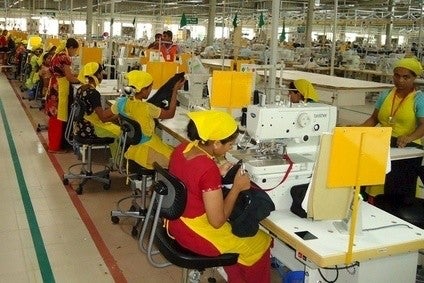
The Accord on Fire and Building Safety in Bangladesh has detailed progress with its Safety Committee Training Program, despite recently admitting major life-threatening safety concerns remain outstanding in too many of the factories it monitors.
In an update on the programme, the body says 844 factories of the 1,699 factories it monitors are now participating. Progress as of 1 December has also seen Safety Committee training completed at 169 factories, while 805 ‘All Employee’ meetings have taken place for more than 1.8m workers.

Discover B2B Marketing That Performs
Combine business intelligence and editorial excellence to reach engaged professionals across 36 leading media platforms.
The meetings introduce all workers in the factory to the members of the Safety Committee – and provided with information on how to identify and reduce common safety hazards, how to safely evacuate the factory in case of fire or other emergencies, and how to use the Accord’s Complaints Procedure. At the end of each meeting, the workers receive a booklet reiterating the information presented.
The Committee Training Programme was introduced in early 2016 with the aim of getting workers and management involved in monitoring safety and health issues on a day-to-day basis and creating a culture of safety.
Through the programme, factory inspections are carried out to identify safety hazards, employee complaints and suggestions are responded to, company accident reports are reviewed with a view to seeking prevention, regular meetings take place, and workers are informed about safety and health issues.
Committees are made up of equal members of worker and management representatives who are elected by their peers and managers. They jointly receive a seven-session training programme from the Accord on supporting remediation, hazard identification, complaints handling, joint problem solving and workplace safety monitoring.

US Tariffs are shifting - will you react or anticipate?
Don’t let policy changes catch you off guard. Stay proactive with real-time data and expert analysis.
By GlobalDataFor example, one aspect of the training will include a factory walk-through, which is carried out in the first training session to identify any potential hazards such as inadequate use of machines, improper maintenance of fire and electrical equipment, obstacles on the work floor, or poor ventilation and lighting.
Once factory management inform the Accord these hazards have been fixed, the Accord engineers will conduct a follow-up inspection.
While the Bangladesh Accord is set to end its five-year term in around six months’ time, it has been granted a six-month extension to operate beyond May 2018 if a new national regulatory body is not ready to take over its work – as is widely anticipated. The so-called ‘Transition Accord’ will then be reviewed every six months until the conditions for handover have been met, followed by a further transition period of six months.
Accord clarifies role in Bangladesh beyond 2018
In a quarterly progress update in November, however, the Accord admitted that major life-threatening safety concerns remain outstanding in too many of the factories it monitors – although it hopes the vast majority will be fully remediated when its initial tenure comes to an end in May.
The Accord noted that just 120 of the 1,699 factories it monitors are 100% remediated from initial inspections, representing around 7% of the total.
Bangladesh Accord admits major safety concerns remain
In its latest update, the body says it is recruiting a head of monitoring and a data systems manager to join its Amsterdam office.
To date, the new Transition Accord has 53 signatories, including Primark, Hennes & Mauritz (H&M) and Inditex – and covers almost 1,200 of the current factories.





